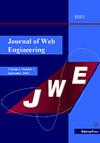A Web Application Framework for Battery Health Prediction in Industrial IoT Networks
IF 1
4区 计算机科学
Q4 COMPUTER SCIENCE, SOFTWARE ENGINEERING
引用次数: 0
Abstract
This study presents a web engineering architecture for predictive battery health management in industrial IoT environments. The proposed framework leverages a scalable web-based platform that integrates data streams, web services, and machine learning modules to estimate the state of charge (SOC) of primary lithium batteries. These batteries are critical for long-term device reliability in applications such as gas advanced metering infrastructure (AMI) networks. To overcome challenges associated with flat discharge profiles and data sparsity, the framework incorporates web-enabled data processing, online augmentation techniques (e.g., CutMix), and adaptive learning models. A key contribution of this work is the design of a modular web application layer compliant with oneM2M standards and RESTful interfaces. It includes components for real-time monitoring, automated model updates, and secure service orchestration using technologies such as HTTP bindings. This architecture not only enables accurate SOC estimation without additional hardware but also demonstrates the critical role of web engineering in ensuring system scalability, security, and integration across heterogeneous IoT devices. Experimental validation in AMI systems confirms the effectiveness of the approach, which is extensible to broader domains such as smart utilities, environmental sensing, and industrial automation.工业物联网中电池健康预测的Web应用框架
本研究提出了一种用于工业物联网环境中预测性电池健康管理的web工程架构。该框架利用了一个可扩展的基于web的平台,该平台集成了数据流、web服务和机器学习模块,以估计一次锂电池的充电状态(SOC)。这些电池对于天然气先进计量基础设施(AMI)网络等应用的长期设备可靠性至关重要。为了克服与平坦放电剖面和数据稀疏相关的挑战,该框架结合了网络支持的数据处理、在线增强技术(例如,CutMix)和自适应学习模型。这项工作的一个关键贡献是设计了一个模块化的web应用层,符合oneM2M标准和RESTful接口。它包括用于实时监控、自动模型更新和使用HTTP绑定等技术的安全服务编排的组件。这种架构不仅可以在没有额外硬件的情况下实现准确的SOC估计,而且还展示了web工程在确保系统可扩展性,安全性和跨异构物联网设备集成方面的关键作用。AMI系统的实验验证证实了该方法的有效性,该方法可扩展到更广泛的领域,如智能公用事业、环境传感和工业自动化。
本文章由计算机程序翻译,如有差异,请以英文原文为准。
求助全文
约1分钟内获得全文
求助全文
来源期刊

Journal of Web Engineering
工程技术-计算机:理论方法
CiteScore
1.80
自引率
12.50%
发文量
62
审稿时长
9 months
期刊介绍:
The World Wide Web and its associated technologies have become a major implementation and delivery platform for a large variety of applications, ranging from simple institutional information Web sites to sophisticated supply-chain management systems, financial applications, e-government, distance learning, and entertainment, among others. Such applications, in addition to their intrinsic functionality, also exhibit the more complex behavior of distributed applications.
 求助内容:
求助内容: 应助结果提醒方式:
应助结果提醒方式:


